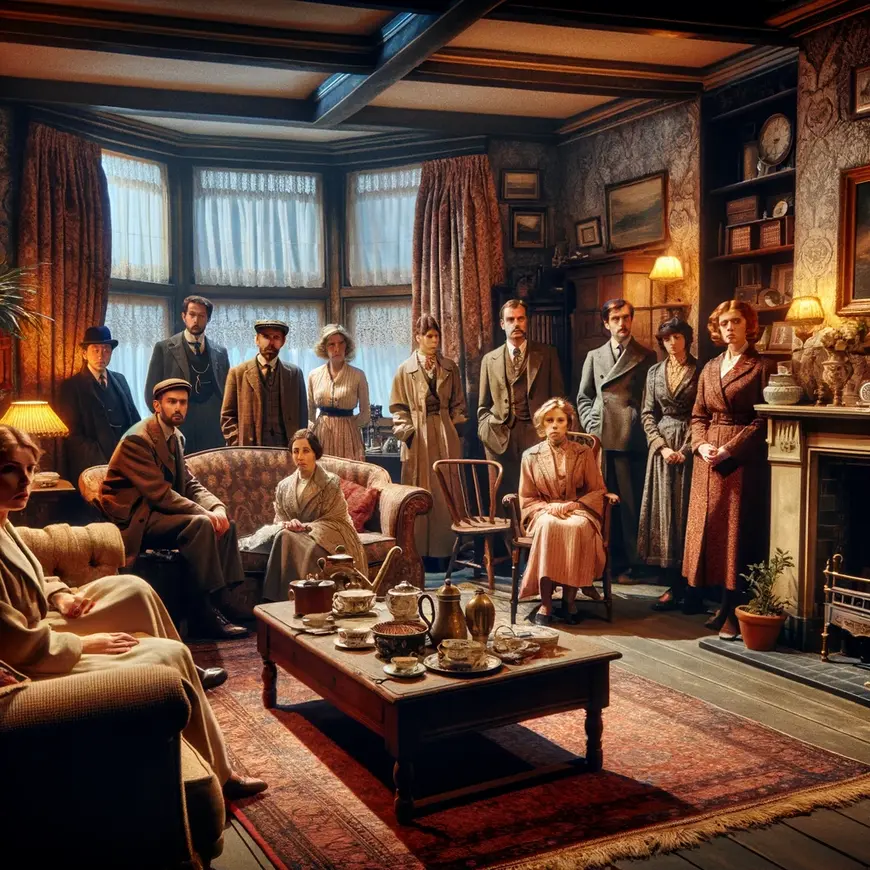Agatha Christie’s “The Mousetrap”: A Thrilling Journey into Murder, Mystery, and Ingenious Plot Twists
Agatha Christie, the unrivaled queen of mystery, invites readers on a spellbinding journey with “The Mousetrap,” a classic whodunit that has captivated audiences for generations. Step into the quaint surroundings of Monkswell Manor, where murder lurks in the shadows, and every character conceals secrets. As the plot thickens, Christie weaves a web of intrigue, suspense, and unexpected twists, keeping readers on the edge of their seats. Brace yourselves for a timeless masterpiece that continues to enchant with its brilliance.
Setting the Stage for “The Mousetrap”: The Intriguing Prelude to Murder
“The Mousetrap” opens its curtains in the snow-covered landscape of England, where Monkswell Manor awaits its guests. The stage is set for an intimate guesthouse experience, but little do the characters know that they are about to become players in a deadly game of deception. The Manor, isolated from the outside world by the wintry landscape, becomes a microcosm where tension simmers beneath the surface.
Agatha Christie, with her masterful storytelling, introduces readers to a diverse cast of characters, each harboring secrets and potential motives. The atmosphere is charged with suspense from the outset, setting the stage for a murder mystery that will keep readers guessing until the very end.

The Whodunit Formula: A Christie Classic
“The Mousetrap” adheres to the quintessential whodunit formula that Agatha Christie perfected throughout her prolific career. A murder is committed, suspects abound, and a detective— in this case, the iconic Sergeant Trotter— arrives to unravel the mystery. The unfolding drama is punctuated by red herrings, misdirection, and a series of ingenious clues that challenge readers to play detective alongside the characters.
Christie’s formula, while familiar to seasoned mystery enthusiasts, is executed with such finesse in “The Mousetrap” that it feels fresh and exhilarating. The author’s ability to craft a compelling mystery without revealing the culprit until the final act is a testament to her narrative prowess and unparalleled skill in keeping readers riveted.
The Unpredictable Plot Twists: Christie’s Signature Move
What sets “The Mousetrap” apart is Agatha Christie’s signature move— the unpredictable plot twists that leave readers gasping in astonishment. Just when one believes they have unraveled the mystery, Christie ingeniously veers the narrative in an unexpected direction. The plot twists are not mere devices to shock but integral elements that enhance the complexity of the mystery.
As the layers of deception are peeled away, readers are treated to revelations that reshape their understanding of the characters and the murder at the heart of the story. The unpredictability of Christie’s narrative keeps the suspense alive, making “The Mousetrap” a rollercoaster of twists and turns that defies easy deduction.
Character Depth: Secrets, Motives, and Suspicion
Agatha Christie excels not only in creating intricate plots but also in crafting characters with depth, secrets, and motives that add layers to the mystery. Each guest at Monkswell Manor becomes a suspect, and Christie expertly manipulates the reader’s perception of each character. From the eccentric Mrs. Boyle to the enigmatic Mr. Paravicini, suspicion hangs over every guest, inviting readers to question their motives and connections to the crime.
The characters’ backstories, intricately woven into the narrative, contribute to the atmosphere of intrigue. Christie invites readers to participate in the detective process, encouraging them to form their own theories about the murderer’s identity. The character depth serves as both a narrative device and a means of engaging readers in the cerebral exercise of solving the mystery.
Monkswell Manor: A Character in Itself
Monkswell Manor, with its isolated setting and snow-covered surroundings, becomes a character in its own right. The manor’s claustrophobic atmosphere, cut off from the outside world, heightens the tension among the characters. The creaking floorboards, dimly lit rooms, and chilling winds contribute to the sense of unease, creating the perfect backdrop for a classic murder mystery.
Christie’s descriptive prowess brings Monkswell Manor to life, enveloping readers in the eerie ambiance of the secluded guesthouse. The manor becomes a microcosm where the characters’ secrets unravel, and the truth behind the murder slowly comes to light. The setting, in its atmospheric richness, becomes an integral element of the storytelling, enhancing the overall immersive experience.
Sergeant Trotter: The Detective Unraveling the Web
Enter Sergeant Trotter, the detective tasked with untangling the web of deceit at Monkswell Manor. As a classic Christie detective, Trotter is astute, methodical, and armed with a keen intuition. His arrival marks a shift in the narrative dynamics, injecting a sense of urgency as he pieces together the puzzle of the murder.
Sergeant Trotter, though an outsider, becomes an integral part of the story, navigating the complex relationships and hidden agendas of the characters. His interactions with each suspect reveal not only the facts of the case but also the psychological undercurrents that drive the narrative forward.
Themes of Trust and Deception in “The Mousetrap”: A Psychological Chess Game
Beyond the murder mystery, “The Mousetrap” delves into themes of trust and deception, transforming the narrative into a psychological chess game. The characters, confined within Monkswell Manor, grapple with their own suspicions and insecurities. Trust becomes a scarce commodity as alliances form and fracture, revealing the fragile nature of human relationships when faced with suspicion and uncertainty.
Christie’s exploration of trust and deception adds depth to the narrative, elevating “The Mousetrap” beyond a mere murder mystery. The psychological dimensions of the characters’ interactions contribute to the overall tension, creating a narrative that resonates with the complexities of the human psyche.

Theatrical Success: Enduring Appeal on Stage
“The Mousetrap” is not just a literary triumph; it has achieved unparalleled success on the theatrical stage. Since its debut in 1952, the play has become the longest continuously running show in the world, a testament to its enduring appeal. The transition from page to stage highlights the universal allure of Christie’s mystery, captivating audiences with its live performances and keeping the identity of the murderer shrouded in secrecy.
The play’s success on stage speaks to the timelessness of the story and its ability to captivate diverse audiences over the decades. The theatrical adaptation, much like the novel, retains the suspense and thrill that make “The Mousetrap” a classic in the realm of mystery fiction.
Legacy “The Mousetrap”: A Whodunit for the Ages
“The Mousetrap” stands as a testament to Agatha Christie’s enduring legacy as the queen of mystery. Its status as a classic is cemented not only by its ingenious plot and memorable characters but also by its ability to captivate new generations of readers and theatergoers. The novel remains a benchmark for the whodunit genre, influencing countless mystery writers who aspire to recreate the magic of Christie’s storytelling.
As readers immerse themselves in the labyrinth of clues and red herrings within “The Mousetrap,” they partake in a literary tradition that transcends time. Agatha Christie’s masterpiece continues to be a thrilling journey into murder, mystery, and the art of keeping audiences guessing until the final revelation. “The Mousetrap” is not just a novel; it’s a testament to the enduring power of a well-crafted mystery that continues to intrigue and delight, leaving an indelible mark on the landscape of detective fiction.